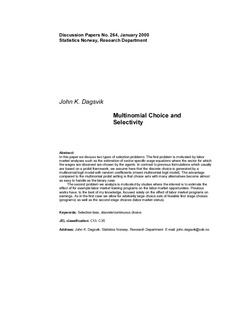| dc.contributor.author | Dagsvik, John K. | |
| dc.date.accessioned | 2011-10-09T10:33:22Z | |
| dc.date.available | 2011-10-09T10:33:22Z | |
| dc.date.issued | 2000 | |
| dc.identifier.issn | 1892-753x | |
| dc.identifier.uri | http://hdl.handle.net/11250/180329 | |
| dc.description.abstract | In this paper we discuss two types of selection problems. The first problem is motivated by labor market analyses such as the estimation of sector-specific wage equations where the sector for which the wages are observed are chosen by the agents. In contrast to previous formulations which usually are based on a probit framework, we assume here that the discrete choice is generated by a multinomial logit model with random coefficients (mixed multinomial logit model). The advantage compared to the multinomial probit setting is that choice sets with many alternatives become almost as easy to handle as the binary case. The second problem we analyze is motivated by studies where the interest is to estimate the effect of for example labor market training programs on the labor market opportunities. Previous works have, to the best of my knowledge, focused solely on the effect of labor market programs on earnings. As in the first case we allow for arbitrarily large choice sets of feasible first stage choices (programs) as well as the second stage choices (labor market status). | |
| dc.language.iso | eng | en_US |
| dc.publisher | Statistics Norway | en_US |
| dc.relation.ispartofseries | Discussion Papers;No 264 | |
| dc.subject | Matematisk statistikk | en_US |
| dc.subject | Utvalgsteori | en_US |
| dc.subject | Økonometriske metoder | en_US |
| dc.subject | Økonometriske modeller | en_US |
| dc.subject | Selection bias | en_US |
| dc.subject | discrete/continuous choice | en_US |
| dc.subject | JEL classification: C13 | en_US |
| dc.subject | JEL classification: C35 | en_US |
| dc.title | Multinomial choice and selectivity | en_US |
| dc.type | Working paper | en_US |
| dc.subject.nsi | VDP::Social science: 200::Economics: 210 | en_US |
| dc.subject.nsi | VDP::Mathematics and natural science: 400::Mathematics: 410::Statistics: 412 | en_US |
| dc.source.pagenumber | 21 s. | en_US |
